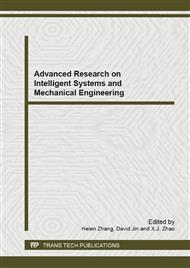p.137
p.141
p.145
p.151
p.157
p.161
p.165
p.171
p.175
Interaction Parameter of BaO-Bi2O3-B2O3-SiO2 Glasses
Abstract:
Interaction parameter A proposed in Yamashita-Kurosawa’s theory of dielectric constant, has been calculated for numerous binary oxide glasses on the basis of polarizability of oxide ion determined from refractive index. However, there are only a few reports on the multi-component oxide glasses system, especially BaO-Bi2O3-B2O3-SiO2 glasses system (G-BBBSO). Bismuth/barium-containing crystals have attracted much attention in application of material engineering because of their importance for the development of nonlinear optical (NLO) information processing technology. Compared to crystals, glasses have shown many advantages in the material engineering, such as easier shaping in casting procedures, low production cost and high thermal and chemical durability. Prompted by these interests in application of material engineering, we reported new data of interaction parameter of BaO-Bi2O3-B2O3-SiO2 glasses system (G-BBBSO) for the different wavelength range (480, 546.1 and 643.8 nm)
Info:
Periodical:
Pages:
157-160
Citation:
Online since:
January 2013
Authors:
Price:
Сopyright:
© 2013 Trans Tech Publications Ltd. All Rights Reserved
Share:
Citation:


